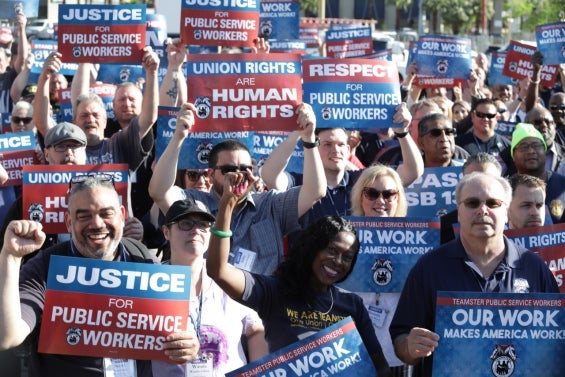Headline News
Teamsters Plan Strategy to Build Member Power at Public Services Division Conference

With more than 200,000 members, the Teamsters Public Services Division is one of the largest in the union. After participating in workshops and trainings geared towards building Teamster power, the 250+ Teamsters who attended the Public Services Division Conference are poised to make it even larger.
“Our Teamster public service workers make our communities safer, healthier, better places to live, and they deserve fair treatment at work,” said Jason Rabinowitz, Public Services Division Director. “That’s why it is so important that we come together and develop strategies to build Teamster power in public service, organize thousands of workers and give our existing membership the best representation that they could possibly have.”
On the first day of the session, In the Public Interest (ITPI) Executive Director Donald Cohen led a workshop on fighting privatization and subcontracting. Cohen stressed that having a proactive and multifaceted approach that involved legislative advocacy, coalition building, and a well thought out communications strategy was essential to pushing back on austerity measures at the state and municipal level. During a discussion, Local 237 Housing Division Director Kevin Norman emphasized that monitoring “pilot programs” had been a successful tactic for unions fighting privatization in his hometown of New York City.
“What public officials are really saying with these ‘pilot programs’ is that they don’t want to hire more people to be in the union and have to pay the salaries or benefits,” Norman said. “You need to be aware of these small pilot programs which can be used to displace you later on down the road.”
Cohen wasn’t the only special guest at the conference – representatives from the Northwest Accountability Project also ran a workshop. The Northwest Accountability Project is a non-profit dedicated to bringing awareness and transparency to corporate-funded right-wing extremist organizations. The NWAP provided Teamsters with a tool kit on how to fight back against organizations like the Freedom Foundation, a dark-money group that targets public sector workers with misleading propaganda designed to convince them they should opt-out of union membership.
Workshop participants all agreed that a dark-money campaign is no match for an educated and mobilized membership. Local 2010 Union Representative Joseph Meyer advocates on behalf of members at the UC Office of the President and UC Berkeley, where he used to work as a records clerk. Meyer said that he and his Local 2010 brothers and sisters have no patience for anti-union pestering from outside agitators.
“They are not welcome on our campus,” said Meyer. “Our members know that at the end of the day, whether it’s the Freedom Foundation or anyone else, all they want to do is take money out of our pockets and give it to the one percent.”
On the second day of the conference, Deputy Organizing Director Kim Keller gave a presentation on Teamster organizing in the public sector, noting that the Teamsters have successfully organized 33,000 public sector workers in the last five years alone. With public sector workers under attack by politicians, there has never been a more important time for them to stand together in a union. At one point, Keller and Rabinowitz asked every Teamster at the conference to pledge that they would add 5,000 public sectors workers to their membership rolls. The audience roared in applause, enthusiastically accepting the challenge.
Keller then moderated a panel discussion on public sector organizing with Local 238 Secretary-Treasurer Jesse Case, Local 14 Vice President Grant Davis, Local 2010 Organizing Director Jesse Mathus, and Local 320 Organizer Claire Thiele. There was extended discussion on the importance of mobilizing millennials in the public sector.
“We have no choice but to attract more young people to our union,” Thiele said. “The good news is that there is a lot of enthusiasm among workers under 35 and a lot of opportunity for growth. We just need to make the case on the importance of joining.”